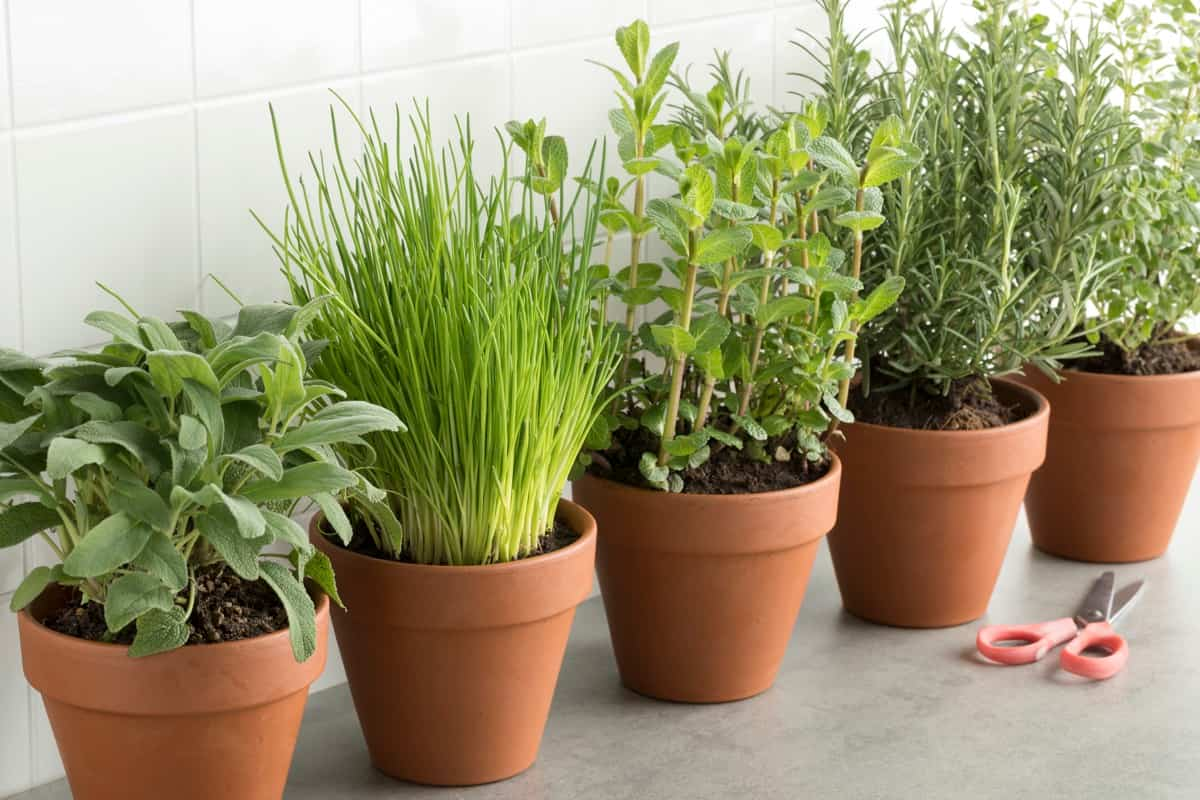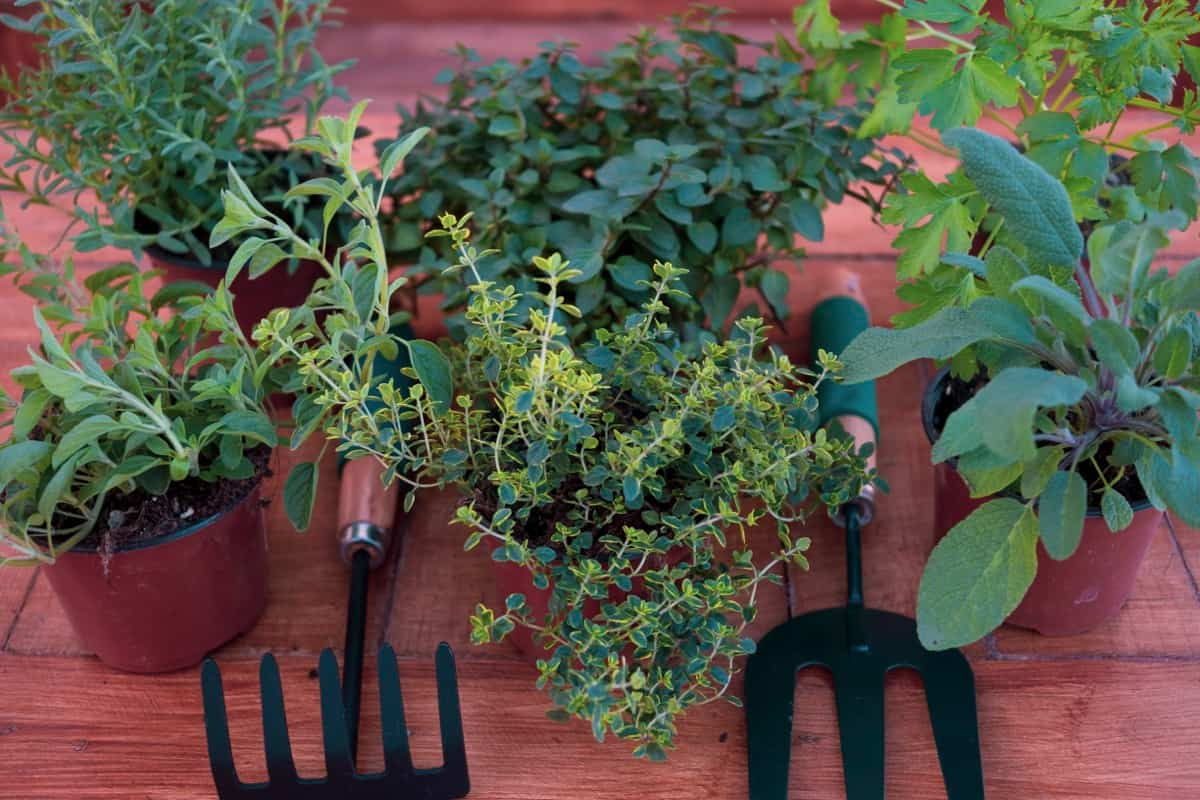Herb gardens don’t need to be huge or take up much space in your yard to be beautiful and useful. Herbs make excellent container garden plants and thrive on decks, patios, balconies, front steps, and window boxes. It is possible to grow many herbs in containers, making them more visible if planted for beauty. The herb family includes annuals and perennials. An annual herb is grown for a single season, harvested when flower buds appear, then discarded. You can bring perennial herbs indoors during the winter because they grow year after year.

Pot/Container Gardening with Herbs
What You’ll Need to Make a Container Herb Garden
- A sunny place to place your containers or grow lights: Plants prefer sunlight, which is free. To get started, you might have to purchase an expensive grow light setup if you live in an apartment without sunny windows.
- Soil to grow in: Since your plants are in small containers, providing them with high-quality soil is important. You can buy potting soil designed specifically for potted plants in garden centers.
- Fertilizer: Nutrients in the soil will eventually be depleted by your plants over time. Fertilizer will be required to keep them in top condition. It is recommended to use organic plant food. A natural alternative to artificial chemicals, these products contain kelp, earthworm castings, and bone meal. Container gardening is best done with a liquid fertilizer.
- A watering can: Watering your container garden will likely require a watering can unless you have a garden hose in your yard. Watering with a watering can also allow you to water more gently than with a hose attachment that uses high pressure.
- Herb seeds or seedlings: Consider what herbs you use regularly in your cooking if you’re unsure what to buy. It is necessary to replant annual herbs like basil and dill every year. Herbs such as sage, rosemary, and thyme can be planted once and will keep growing.
Step-By-Step Instructions for Planting a Container Herb Garden
Choose Location
Container gardens have the advantage of being portable. It is easy to arrange them on a deck, doorstep, edging pathways, patios, or in window boxes for you to enjoy their beauty and fragrance. Despite this, not all plants grow well under the same conditions. In arid climates, some plants thrive, while others prefer cooler, moister conditions.
Plan Your Herb Container
In each container, you can grow only one kind of herb. You could also combine multiple kinds of herbs in one container. However, it is important to put plants together that have similar needs. It is important to consider soil, water, and sun preferences. Mint, for example, grows best in wet conditions. On the other hand, rosemary thrives in hot, dry conditions. Therefore, you shouldn’t plant these types of herbs together.
Pick Your Container
Herb containers are available at garden centers specially made for herbs. You can also use almost any container to create your herb garden ideas. The bottom should have some drainage holes, and the size should be big enough. Herbs usually don’t have deep roots. Therefore, shallow and small containers will work well for them.
In case you missed it: How to Prevent Pests and Diseases in Potted Plants

Plant Your Herbs
All of the supplies we discussed earlier should be in your possession. You just need to fill your pots with soil and plant herb seeds or seedlings. Water preferences are the most important factor when choosing herbs for a container. The soil near the container edge will be the first to dry out, so plant herbs such as rosemary, oregano, marjoram, lavender, sage, and thyme there. Herbs like to stay dry and do well when grown together. The soil should be consistently moist for dill, cilantro, parsley, and basil.
Caring for Your Herbs
Plants and seeds of herbs should be cared for according to the instructions that come with them. The majority of herbs, however, require six to eight hours of sunlight each day. A finger inserted below the soil’s surface will tell you if your herbs need watering. When it feels dry, it’s probably time to water. During the summer, small herb containers can become very hot. Placing them somewhere that will provide shade during the hottest day might be a good idea. Make sure you adjust the amount of fertilizer based on the container size and follow the fertilizer instructions.
Harvest Your Herbs
Cutting off growth regularly will cause most herbs to bush out, grow even larger, and fill out even thicker. Start harvesting herbs even when small, so don’t be afraid. Your herbs’ roots and other parts may be damaged by pulling leaves off with your fingers. Using scissors or a knife is recommended when harvesting herbs.
Keeping Your Herbs Over Winter
Keeping your herbs alive even when it’s cold outside is an optional step. Some perennials go dormant in winter and return in the spring if you don’t bring them inside. It is necessary to replant annual herbs in the spring. You can, however, bring either herb inside once the weather gets cold to extend the growing season.
Pros and Cons of Container Herb Gardens
Pros
- You can build your confidence as a new gardener by creating a container herb garden.
- It requires little maintenance. Watering and fertilizing are the only things you need to do. There is no difficulty in weeding.
- Herb gardens in containers don’t take up much space. It’s great even for people who live in apartments with only balconies.
- It is possible to place containers right outside your door. The process of watering or harvesting fresh herbs does not require much effort.
- You can pick up and move containers whenever you want. Taking your plants with you is easy if you move. Nothing needs to be dug up.
In case you missed it: Pruning and Trimming Techniques for Container Plants

Cons
- In smaller containers, there is less soil to hold water since they have less volume. Additionally, they tend to heat up faster, leading to faster evaporation. Herbs grown in containers need more water than herbs grown in the ground.
- Herbs grown in small containers require fertilizer. It’s another input you need to purchase. Fertilizer is also required for container growing, which makes it less sustainable.
- Herbs that grow quickly can outgrow their containers quickly. If so, you might need to replant them in a larger container.
- Despite being filled with soil, a strong gust of wind can toss plastic containers around or knock them over. Depending on how bad it is, your plants might be damaged or end up flying out of their containers.
Conclusion
Herb gardens in containers can reduce your grocery bills. The maintenance of small gardens is also easier than that of a large one. A container herb garden might be all you have room for if you live in an apartment. Even if you have several acres on your homestead, they are convenient. Also, they are great for beginners. Your container herb garden can be created regardless of your experience level.
- Feed Your Flock for Less: Top 10 Tips to Save on Chicken Feed
- Ultimate Guide to Ossabaw Island Hog: Breeding, Raising, Diet, and Care
- Hatching Answers: The Top 10 Reasons Your Chickens Aren’t Laying Eggs
- Eggs and Economics: Breaking Down the Cost of Raising Backyard Chickens
- Defend Your Greens: Proven Methods to Keep Iguanas Out of Your Garden
- Ultimate Guide to Cinnamon Queen Chicken: A Comprehensive Guide for Beginners
- Ultimate Guide to California Tan Chicken: Breeding, Raising, Diet, Egg-Production and Care
- Ultimate Guide to Marsh Daisy Chicken: Breeding, Raising, Diet, and Care
- 10 Types of Chicken Farming Businesses You Can Start for Profits